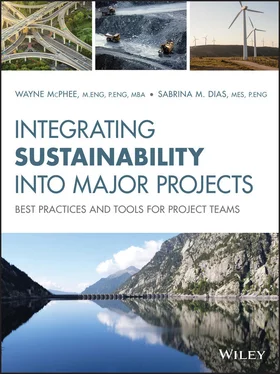When we face changes that encompass several disciplines, there is a need for collaboration with multidisciplinary teams that can bring a broad range of experience and expertise to the problem. These multidisciplinary project teams are comprised not just of technical specialists, but may include new team members who have valuable knowledge of the challenges facing the project, including socioeconomic and geopolitical experts, academics, stakeholders, and a facilitator who can bring the team together. Complexity is the new reality and project teams need to find ways of working together and with key stakeholders to meet this challenge and create better, more sustainable projects.
As projects move toward a sustainability focus, stakeholder engagement is shifting from compliance and risk mitigation to looking for opportunities that create positive relationships that can uncover the project's potential to co-create value for both the organization and local communities. This has been named “Creating Shared Value” by Porter and Kramer. 4
Opportunities for collaborating and co-creating value can be evaluated by answering a number of initial questions aimed at understanding both the planned or current project impacts and the potential for value creation, but also the potential for new activities that can create shared value that neither player could achieve on their own. These questions are:
1 What impact(s) does the project and its activities have on each element of the society?
2 What impacts could we change or improve if we changed how the project was delivered?
3 What impacts could the element of society have on the project?
4 What benefits could we co-create if we work together to address impacts and challenges?
The initial questions are intended as only a first step. True co-creation cannot be achieved by one side of the relationship acting alone. It requires ongoing dialogue and interaction to create understanding and new ideas.
One model for co-creating value is the DART model, 5 which we have adapted from a business model for working in developing economies. DART, which stands for Dialogue, Access, Risk Assessment, and Trust/Transparency, suggests that you need to focus on the four elements to fundamentally change the traditional relationship between the project and the local community, as shown in the sidebar.
TIP: “DART” MODEL FOR CO-CREATING VALUE
The four elements of the DART model are:
Dialogue: Dialogue includes two-way communication (rather than a one-way flow of information), shared learning, and collective problem solving. Project teams need to approach stakeholders as partners in problem identification and problem solving, and not as barriers to be managed. Communities need to engage in the process to create value for their community.
Access: Ensure that stakeholders have access to the project team and, in particular, to the right people in the team. This includes active engagement through meetings and participation in the local community. One of the keys to ensuring good access is to ask stakeholders how they would like to communicate and offer them opportunities to try out different methods.
Risk Assessment: Risk encompasses not just the potential for harm to the local community but the perception of potential harm. Everyone on the project team should understand that the community's perception of risk is important and should be treated with respect, rather than dismissed as a lack of understanding.
Trust and Transparency: The project team controls most of the information about the project, so the local community may feel that they are being misled about the potential negative impacts of a project. Establishing trust requires transparency and honesty so that all players can understand the potential impacts and work together to co-create solutions to these challenges. To ignore or downplay potential impacts not only damages trust but also shuts down any potential for creating solutions and shared value.
Understanding Community Support
Historically, formal approval for major projects meant convincing government regulators that the project was in the best interest of the government. As local communities and stakeholders gain more influence, it is becoming essential for projects to demonstrate that they have the support of the local community and can maintain that support to successfully deliver the project.
There are a number of different terms that are used to capture this idea of establishing stakeholder support. Depending on your organization or industry you may need to use one or all of these terms, including:
Social capital
Good will
Public support
Community support
Social license to operate (SLO)
“Social license to operate” implies that there is an actual license or signed document to demonstrate the project has required support to move forward, but there is no such formal license. SLO is simply shorthand to indicate that there is a positive relationship with the local community and that they support the project, at least at the present time. “Securing an SLO” essentially means earning the trust of the project's local communities and building strong, mutually respectful relationships with them. It is important to understand that SLO is not a legal document and that stakeholders can “revoke” their project support (i.e. the SLO) at any time and without notice.
Social capital and good will are terms that suggest that you can place an economic value on relationships with stakeholders and local communities. Good will can be used in a social context to mean that a person is trusted. In the accounting context it is used to represent the intangible assets that an organization has, such as brand value, reputation, and intellectual property.
In the context of a major project, social capital and good will relate to the value that exists in the strength of the relationships with the local community, which can be leveraged to help make the project a success. Strong relationships mean a high level of mutual respect and trust and much of this value is based on how the local community perceives the project and how they feel they are being treated by the project team.
Having a high level of social capital helps projects in many ways, including fewer project delays due to community disputes, faster permitting, and a more engaged local work force. Social capital provides value if there is a problem or an unforeseen environmental or social incident. With strong social capital, the project will be able to address the problem with limited negative backlash and perhaps local support to resolve issues faster.
TIP: MANAGING YOUR SOCIAL CAPITAL BANK ACCOUNT
Discussing the concept of social capital with a traditional project team can be a challenge. The concept of social capital may seem vague or may be seen as irrelevant to the team members focused on design and construction activities.
One analogy we have found to be effective is the metaphor of a “Social Capital Bank Account,” which holds the project's trust and reputation with the local community. Maintaining a healthy bank account can help to avoid delays and secure approvals on time. When your bank account is full, local stakeholders will not stand in the way of permits/approvals and may even vouch for your project with the local government and regulators.
Every time the team does something positive for the local community, such as taking time to listen and treating people with respect, you are putting “money” into the bank. Every time you mismanage a spill or ignore a complaint, you are losing “money” from the bank. Lose enough and all the social capital is gone.
Each project department should understand that they have a role in filling the Social Capital Bank Account, whether it is engineering who must consider alternate roads to preserve a local sacred site, or construction who must reconsider shift schedules to accommodate local hunting seasons. Everyone on the team has the potential to help fill the bank or to break the bank. The collective objective of the team is to maintain a full Social Capital Bank Account over time so that the project can move ahead smoothly.
Читать дальше












